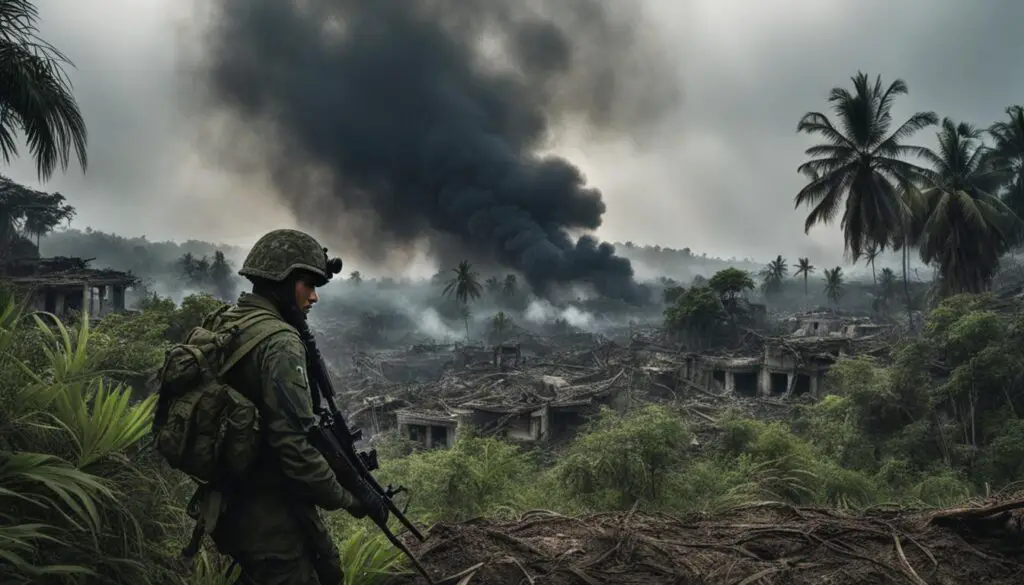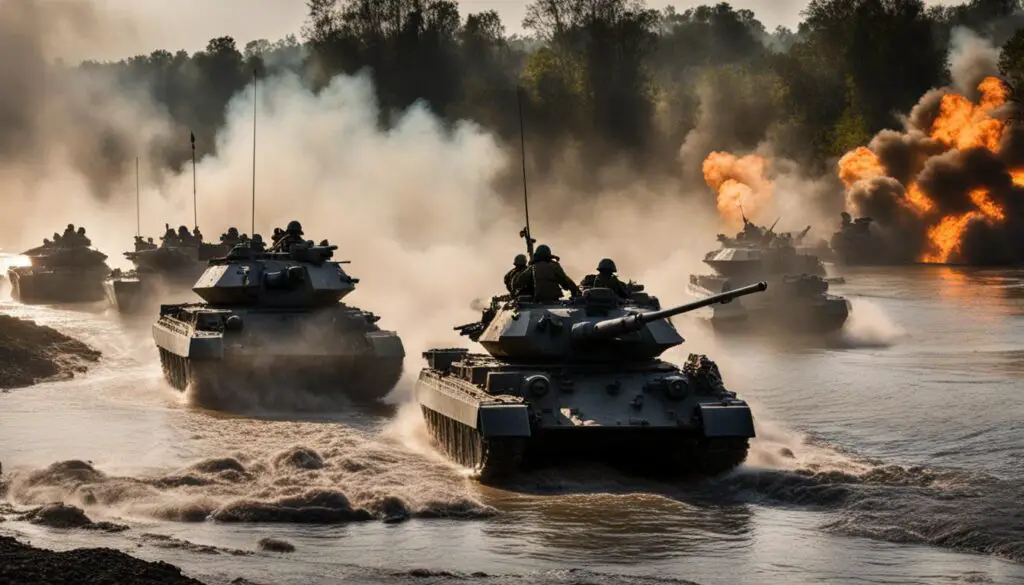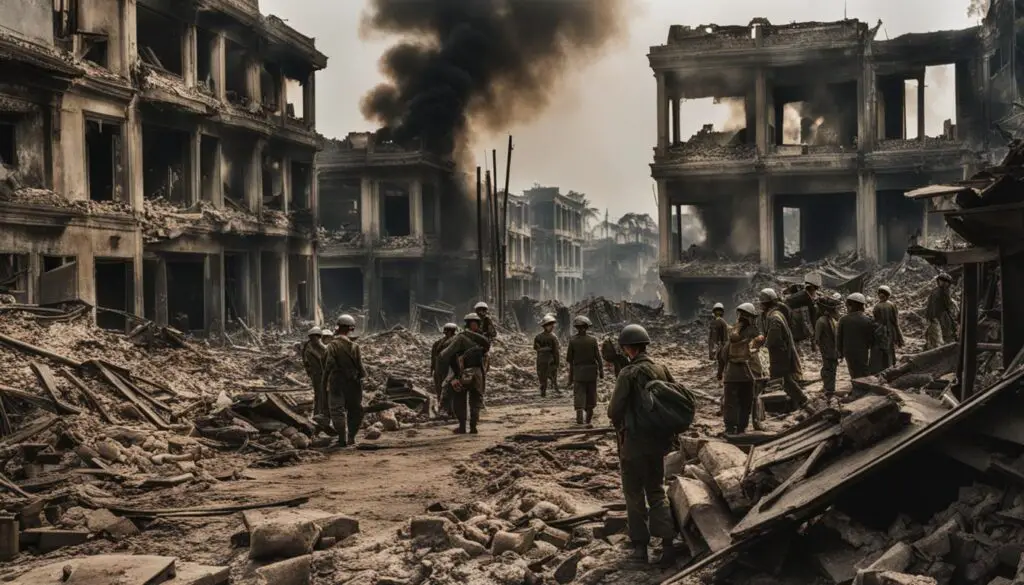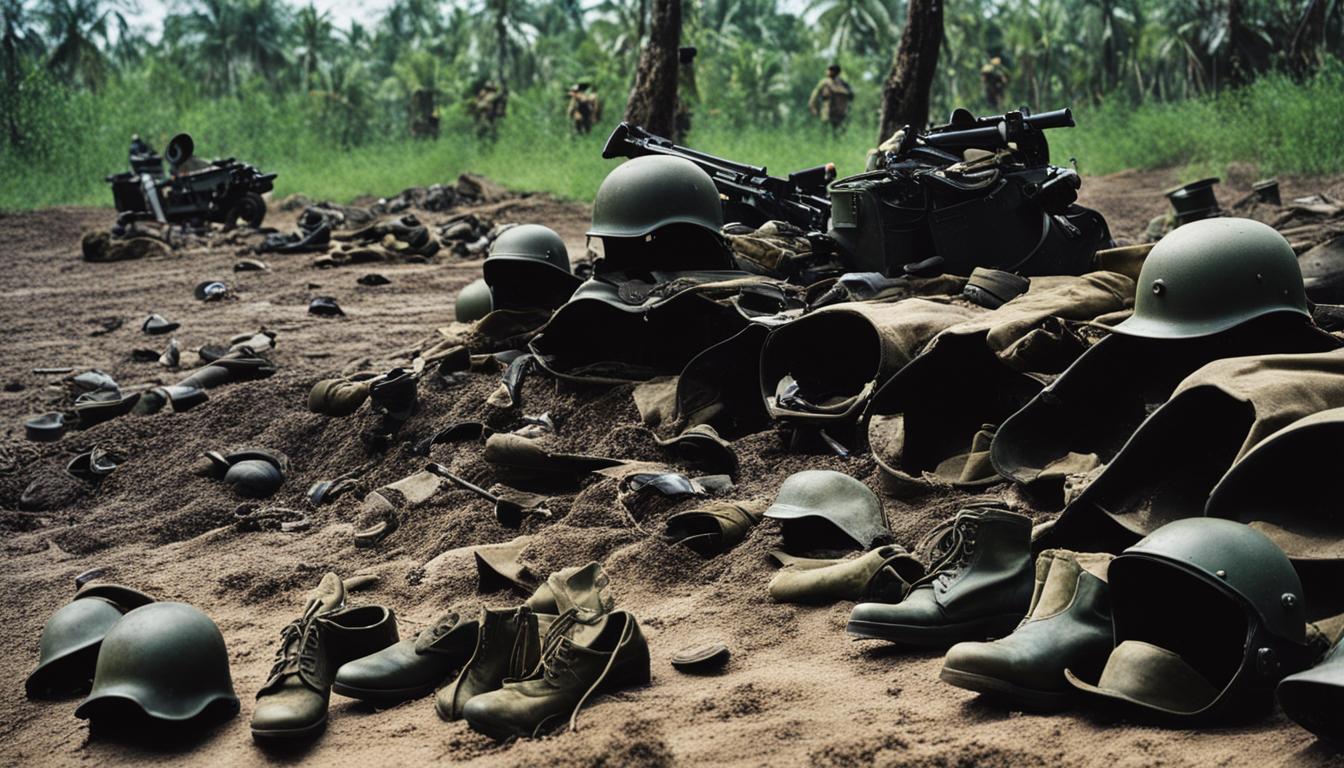The Vietnam War was a protracted conflict that took place from 1954 to 1975, resulting in a devastating loss of life. It was a war between North Vietnam, led by Ho Chi Minh, and South Vietnam, supported by the United States. The consequences of this conflict were far-reaching, impacting both the Vietnamese people and the United States.
Key Takeaways:
- An estimated 2 million civilians and 1.1 million North Vietnamese and Viet Cong fighters lost their lives during the Vietnam War.
- Over 58,000 American soldiers also sacrificed their lives in the conflict.
- The war had significant psychological and social impacts, with many veterans suffering from post-traumatic stress disorder.
- Divorce, suicide, alcoholism, and drug addiction rates were higher among veterans compared to the general population.
- The Vietnam War deeply divided the United States and had lasting consequences for both countries involved.
Roots of the Vietnam War
The Vietnam War was a complex conflict with deep-rooted causes. To understand its origins, we must look back to Vietnam’s history under French colonial rule. In the 19th century, Vietnam became a French colony, subject to exploitation and control. However, during World War II, Japan invaded Vietnam and the Vietnamese people saw an opportunity to fight for independence.
Ho Chi Minh, a revolutionary leader, formed the Viet Minh, a political organization dedicated to liberating Vietnam from foreign rule. In 1945, after Japan’s defeat, the Viet Minh took control of Hanoi and established the Democratic Republic of Vietnam (DRV) with Ho Chi Minh as its president. France, seeking to regain control, backed Emperor Bao Dai and set up the state of Vietnam in the south.
This division laid the foundation for the Vietnam War. Both the DRV and the state of Vietnam desired a unified Vietnam, but with different political systems and allegiances. The stage was set for a prolonged conflict, with global implications.

Key Figures and Organizations
In understanding the roots of the Vietnam War, it is crucial to recognize the role of key figures and organizations. Ho Chi Minh, the leader of the DRV, played a central role in the fight for independence and later in the war against the United States. His leadership and determination inspired many Vietnamese people to join the cause.
The Viet Minh, under the guidance of Ho Chi Minh, united individuals from various backgrounds who shared a common goal: liberation from foreign powers. The Viet Minh’s resistance efforts against French colonial rule laid the groundwork for the subsequent conflict.
These key figures and organizations set the stage for the Vietnam War, shaping the events that unfolded and the numerous lives that were tragically lost.
| Key Figures | Organizations |
|---|---|
| Ho Chi Minh | Viet Minh |
| Emperor Bao Dai | State of Vietnam |
When Did the Vietnam War Start?
The Vietnam War officially began in 1954, although the conflict in the region had been ongoing for several decades. The turning point came with the decisive Battle of Dien Bien Phu in May 1954, which marked the end of French colonial rule in Indochina. This significant victory for the Vietnamese forces led to the subsequent Geneva Conference, where Vietnam was divided along the 17th parallel.
The Geneva Conference, held in 1954, aimed to find a peaceful solution and establish a temporary division of Vietnam. The conference called for nationwide elections in 1956 to determine the future of the country. However, the South Vietnamese leader, Ngo Dinh Diem, refused to participate in these elections, fearing a communist victory. This refusal deepened the political divide and ultimately led to increased conflict between the northern and southern forces.
The Battle of Dien Bien Phu and the subsequent Geneva Conference were pivotal moments that marked the beginning of the Vietnam War. While the conflict had been simmering for years, these events solidified the division of Vietnam and set the stage for the years of intense fighting that followed.

The table below provides a timeline of key events leading up to the official start of the Vietnam War:
| Year | Event |
|---|---|
| 1945 | Ho Chi Minh declares independence for Vietnam |
| 1954 | Battle of Dien Bien Phu |
| 1954 | Geneva Conference divides Vietnam |
| 1955 | Ngo Dinh Diem takes power in South Vietnam |
| 1956 | Nationwide elections canceled |
As the table shows, the Battle of Dien Bien Phu and the Geneva Conference were critical events that set the stage for the Vietnam War. The refusal to hold nationwide elections in 1956 further deepened the divide between the northern and southern forces, fueling the escalating conflict that would define the next two decades.
The Viet Cong
The Viet Cong, also known as the National Liberation Front (NLF), played a crucial role in the Vietnam War. Composed of Vietnamese communists and non-communist opponents of the South Vietnamese government, the Viet Cong aimed to organize resistance and overthrow the repressive regime of President Ngo Dinh Diem in the south.
Formed in 1960, the Viet Cong began engaging in firefights with the South Vietnamese army by 1959. The conflict escalated as the U.S. supported Diem and his forces, providing training and equipment. The Viet Cong’s guerrilla tactics and intimate knowledge of the terrain proved challenging for the U.S. military.
The Viet Cong’s influence extended beyond military operations. They established a shadow government in areas they controlled, providing social services and infrastructure to win the support of the local population. This allowed them to maintain a strong presence and carry out their operations effectively.
Table: Comparison of the Viet Cong and South Vietnamese Army
| Aspect | Viet Cong | South Vietnamese Army |
|---|---|---|
| Ideology | Communist | Supported by the United States |
| Tactics | Guerrilla warfare | Conventional military tactics |
| Support Base | Rural population and local sympathizers | Supported by the South Vietnamese government and the United States |
| Control | Established a shadow government in areas they controlled | Officially recognized government in South Vietnam |
The Viet Cong’s resilience and determination significantly contributed to the escalation of the Vietnam War. Their guerrilla tactics and ability to mobilize local support made them a formidable adversary for the South Vietnamese government and its American allies. Understanding the role of the Viet Cong is crucial for comprehending the dynamics and complexities of this tragic conflict.
Domino Theory
The domino theory played a crucial role in shaping U.S. policy and military presence in Southeast Asia during the Vietnam War. It was based on the belief that if one country in the region fell to communism, neighboring countries would inevitably follow, effectively creating a “domino effect.” This theory was rooted in the fear that the Soviet Union and China would expand their influence and control in the region, posing a threat to U.S. interests and global stability. To prevent this perceived threat, the United States increased its military involvement in Vietnam.
The domino theory gained traction during the Cold War era, when tensions between the United States and communist countries were high. U.S. policymakers believed that containing the spread of communism was of utmost importance, as they feared its potential impact on global politics and security. They saw Southeast Asia as a strategic region that needed to be protected from communist influence, as it held significant economic and geopolitical importance.
In light of the domino theory, the United States escalated its military presence in Vietnam. By increasing its troop levels and providing military aid to South Vietnam, the U.S. aimed to prevent the fall of the country to communism and maintain its position as a global superpower. This military intervention, however, ultimately had devastating consequences and contributed to the protraction and escalation of the Vietnam War.
The Impact of the Domino Theory
The domino theory had a profound impact on the Vietnam War and its aftermath. The U.S. military presence and intervention in Vietnam resulted in a prolonged and costly conflict, with significant loss of life and widespread destruction. Moreover, the belief in the domino theory fueled public skepticism and opposition to the war, leading to widespread protests and demonstrations both in Vietnam and the United States.
In retrospect, the domino theory has been widely criticized for its simplistic view of communism and its failure to accurately predict the outcome of the Vietnam War. Critics argue that the theory ignored the complex dynamics and internal factors at play in each Southeast Asian country, oversimplifying the spread of communism as a monolithic process. Furthermore, the domino theory failed to recognize the importance of nationalism and local movements in shaping the political landscape of each country.
While the domino theory may have influenced U.S. policy and military strategy during the Vietnam War, its lasting impact serves as a reminder of the complexities and consequences of geopolitical theories. The tragedy of the Vietnam War and the immense human cost should prompt a critical evaluation of such theories and a commitment to seeking peaceful solutions to global conflicts.

Tet Offensive
The Tet Offensive, launched by the North Vietnamese in 1968, was a major turning point in the Vietnam War. Led by General Vo Nguyen Giap, the offensive was a coordinated series of attacks on cities and towns throughout South Vietnam. While the communists were unable to hold their targets for long, the offensive had a significant impact on U.S. public opinion and the course of the war.
“We were not expected,” said General Giap, reflecting on the surprise element of the offensive. “The enemy thought we were weak, but we proved them wrong.”
The Tet Offensive marked a strategic shift for North Vietnam, as it demonstrated their ability to strike major targets and highlighted the vulnerability of the South Vietnamese government and its American allies. The scale of the attacks also shattered the perception that the war was nearing its end and that the U.S. was making progress.
The offensive had a profound effect on U.S. public opinion, as media coverage brought the realities of war into American living rooms. Seeing the scale of the attack and the determination of the North Vietnamese forces, many Americans began questioning the government’s narrative of progress and victory. Protests and demonstrations against the war intensified, demanding an end to the conflict and the withdrawal of U.S. troops.

Despite the heavy casualties inflicted on the North Vietnamese forces, the Tet Offensive demonstrated their resilience and determination. It also exposed the limitations of the American military strategy and raised doubts about the effectiveness of U.S. involvement in Vietnam. The offensive eventually led to peace talks between the United States, North Vietnam, and the Provisional Revolutionary Government of South Vietnam (PRG), but the war continued for several more years before a final resolution was reached.
Vietnam War Protests
The Vietnam War sparked a wave of protests and demonstrations in the United States, as opposition to the war grew and public sentiment turned against American involvement. The anti-war movement gained momentum throughout the later years of the conflict, with activists organizing rallies, marches, and sit-ins to voice their dissent.
One of the most significant anti-war protests was the Moratorium to End the War in Vietnam, which took place on October 15, 1969. An estimated 2 million people across the United States participated in this nationwide event, making it one of the largest protest movements in American history. The Moratorium was intended to be a peaceful demonstration against the war, with participants engaging in activities such as teach-ins, speeches, and candlelight vigils.
The Vietnam War protests were not limited to college campuses and activist groups. They attracted a diverse range of participants, including veterans who opposed the war. Many returning soldiers were disillusioned by their experiences in Vietnam and became vocal critics of U.S. involvement. These veterans played an important role in raising awareness of the hardships faced by servicemen and women and contributed to the overall anti-war sentiment.
“I went to Vietnam as a young man with a sense of duty and patriotism. But what I saw and experienced there changed me forever. The war was senseless, and innocent lives were being lost every day. I couldn’t stand by silently anymore, so I joined the protests and spoke out against the war.” – Vietnam War veteran
The Vietnam War protests had a significant impact on public opinion and played a role in shaping U.S. government policies. As the anti-war movement gained traction, policymakers began to reconsider their approach to the war. The protests contributed to a shift in public sentiment, leading to increased pressure for an end to the conflict and a reevaluation of U.S. military involvement in Vietnam.
Table: Anti-War Protests in the United States (1965-1973)
| Year | Event | Estimated Number of Participants |
|---|---|---|
| 1965 | March on Washington | 25,000 |
| 1967 | March on the Pentagon | 50,000 |
| 1969 | Moratorium to End the War in Vietnam | 2 million |
| 1970 | Kent State Shootings Protest | 100,000 |
| 1971 | May Day Protests | 30,000 |
The Human Cost
The Vietnam War resulted in a staggering number of casualties, with devastating impacts on both sides of the conflict. It is estimated that approximately 2 million civilians lost their lives during the war, along with 1.1 million North Vietnamese and Viet Cong fighters. The United States also suffered significant losses, with over 58,000 American soldiers killed.
However, the human cost of the Vietnam War goes beyond the sheer number of casualties. Many veterans who returned from the war experienced profound hardships and mental health issues, including post-traumatic stress disorder (PTSD). The trauma and brutality of the war left a lasting impact on those who served, leading to higher rates of divorce, suicide, alcoholism, and drug addiction among veterans compared to the general population.
“The war is over for me now, but it will always be with me, like a scar.” – Tim O’Brien
These hardships faced by veterans highlight the long-lasting consequences of the Vietnam War. The physical and psychological toll on individuals and their families cannot be overstated. It is crucial that we recognize and support those who have endured such hardships as a result of their service in Vietnam.
Conclusion
The Vietnam War was a tragic chapter in American history, causing a significant loss of life and leaving a lasting impact on all those involved. The conflict spanned over two decades and resulted in the deaths of approximately 2 million civilians, 1.1 million North Vietnamese and Viet Cong fighters, and over 58,000 American soldiers. These staggering numbers serve as a stark reminder of the tragic human cost of the war.
However, the impact of the Vietnam War was not limited to the loss of lives alone. It also had profound psychological and social consequences. Many veterans experienced post-traumatic stress disorder (PTSD), and rates of divorce, suicide, alcoholism, and drug addiction were higher among veterans compared to the general population. These lingering effects continue to affect the lives of those who served and their families.
The Vietnam War deeply divided the United States, with changing public opinion and anti-war protests becoming more prevalent as the conflict escalated. It was a complex war, influenced by political ideologies and Cold War tensions. The tragedy of Vietnam War deaths serves as a reminder of the need to understand and reflect upon this significant period in history, to ensure that we learn from the mistakes of the past and strive for peace in the future.
FAQ
How long did the Vietnam War last?
The Vietnam War took place from 1954 to 1975, lasting for 21 years.
How many people died in the Vietnam War?
Estimates suggest that around 2 million civilians, 1.1 million North Vietnamese and Viet Cong fighters, and over 58,000 American soldiers were killed.
What were the root causes of the Vietnam War?
The Vietnam War stemmed from a complex set of factors, including French colonial rule, the desire for Vietnamese independence, political ideologies, and Cold War tensions.
Why did the United States get involved in the Vietnam War?
The United States supported South Vietnam to prevent the spread of communism, as it feared the domino effect of one Southeast Asian country falling to communism.
What was the Tet Offensive?
The Tet Offensive was a series of coordinated attacks by the North Vietnamese and Viet Cong on cities and towns in South Vietnam, launched in 1968.
Did the Vietnam War lead to protests in the United States?
Yes, the Vietnam War sparked protests and demonstrations in the United States, with many Americans opposing the war and its impact on civilian casualties and the South Vietnamese government.
What were the consequences of the Vietnam War for veterans?
Many Vietnam War veterans suffered from post-traumatic stress disorder (PTSD) and faced challenges such as higher rates of divorce, suicide, alcoholism, and drug addiction.
What was the human cost of the Vietnam War?
The Vietnam War resulted in a devastating loss of life, with estimates of as many as 2 million civilian deaths, 1.1 million North Vietnamese and Viet Cong fighters killed, and over 58,000 American soldiers killed.
What is the significance of understanding the tragedy of Vietnam War deaths?
Understanding the tragedy of Vietnam War deaths is essential for comprehending this significant period in history and its lasting effects on both Vietnam and the United States.
Source Links
- https://www.history.com/topics/vietnam-war/vietnam-war-history
- https://www.britannica.com/event/Vietnam-War
- https://whyy.org/articles/why-did-58000-americans-die-in-the-vietnam-war-and-3-million-vietnamese-qembers-of-warq/

